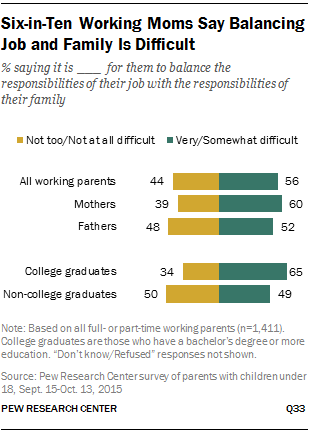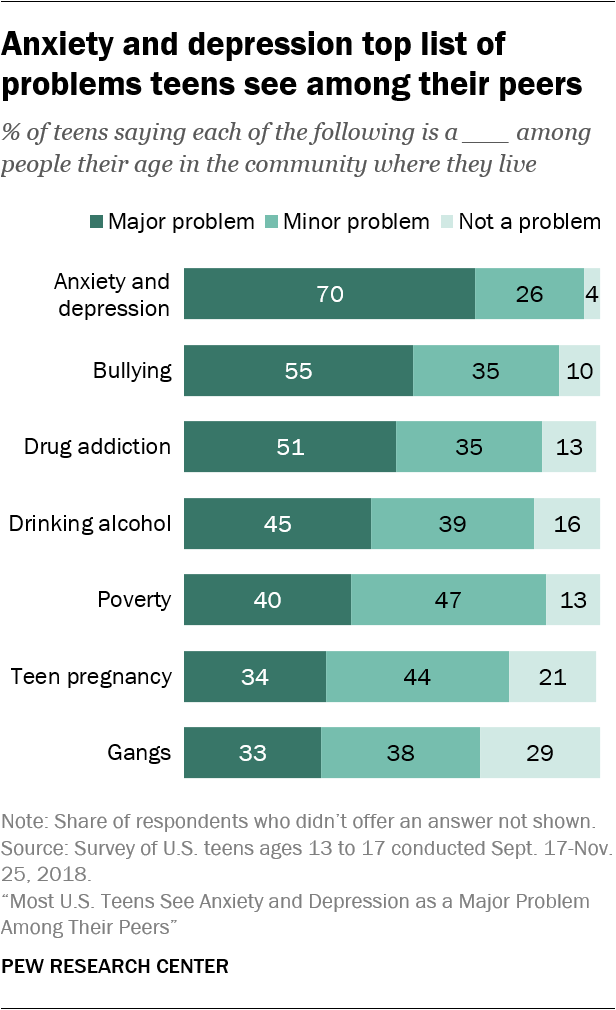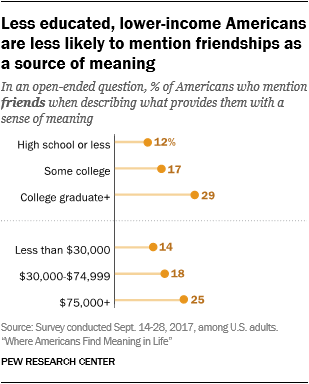
Most Americans are at least somewhat happy with their lives, but some have grappled with issues like loneliness and isolation, work-life balance and finding meaning and purpose. Over the years, Pew Research Center has conducted surveys in all these areas. Here are nine things we’ve learned from them about how Americans are coping with modern life:
1Most – but not all – Americans find some meaning in their job. In a 2017 Pew Research Center survey, 70% of U.S. adults said that their job or career provided them with at least some meaning, with a third (34%) saying they derived a great deal of meaning from their jobs, compared with the 29% whose jobs gave them little or no meaning. And when asked in a separate 2017 survey to describe in their own words what makes their lives feel meaningful, around a third of Americans (34%) mentioned their job or career. Those who did tended to be more satisfied with their lives than others, regardless of their education or income.
For this analysis, we drew from a number of previous Pew Research Center reports, using data from multiple surveys conducted between 2015 and 2018 via the Center’s American Trends Panel, NORC’s AmeriSpeak Panel, and telephone polls. Some of the surveys interviewed all U.S. adults, while others interviewed U.S. teens or U.S. parents. Links to relevant reports that cover each survey in greater depth can be found in the post.
2Americans feel busy, but not too busy to enjoy life. Modern life appears to require a lot of multitasking: In a 2016 survey, about half of Americans (52%) said they’re usually trying to do two or more things at once. But just 11% of Americans said the fast pace of their lives was harming their health. In a 2018 survey, 60% of U.S. adults said they at least sometimes felt too busy to enjoy life, but just 12% said they felt this way all or most of the time.
 3Parents have a harder time with the speed of modern life. Parents of children under the age of 18 appear to have a harder time with the speed of modern life than those with older children or non-parents. In a 2018 survey, 74% of these parents said they at least sometimes felt too busy to enjoy life, compared with 55% of Americans with older children or no children at all. Parents of young children were also nearly twice as likely to say they felt this way all of most of the time (18% vs. 10%).
3Parents have a harder time with the speed of modern life. Parents of children under the age of 18 appear to have a harder time with the speed of modern life than those with older children or non-parents. In a 2018 survey, 74% of these parents said they at least sometimes felt too busy to enjoy life, compared with 55% of Americans with older children or no children at all. Parents of young children were also nearly twice as likely to say they felt this way all of most of the time (18% vs. 10%).
In a 2015 study that focused specifically on American parents with children under 18, nearly a third (31%) said they always felt rushed. And while the overwhelming majority of parents found parenthood enjoyable (90%) and rewarding (88%) most or all of the time, sizable shares also found being a parent tiring (33%) and stressful (25%). Among parents with jobs, 56% said it was difficult to balance the responsibilities of their job and family.
4Technology and information overload are making life more demanding for some. Technology seems to be having a mixed impact on American workers. Over a third of employed Americans (39%) say technology has generally made their work more demanding, while 29% say it has made their work less demanding, according to a 2017 survey. The speed and volume of information may be playing a role in the demands of modern life: Three-in-ten Americans said in 2016 that they’re often stressed by the amount of information they need to consider when making important decisions, and 16% said they frequently don’t have enough time to gather all of the information they need when doing so.
 5Americans are more likely to see social media as providing connections with others than causing negative experiences. While prior Center research has found that exposure to social media content may indirectly make some people feel stressed, Americans say they are more likely to find connection online than to have negative experiences. In a 2018 survey of U.S. social media users, a majority (71%) said they frequently or sometimes see content that makes them feel connected on social media. Fewer said they encountered negative content, though 49% said they frequently or sometimes see things that make them feel depressed and 31% said they frequently or sometimes see content that makes them feel lonely.
5Americans are more likely to see social media as providing connections with others than causing negative experiences. While prior Center research has found that exposure to social media content may indirectly make some people feel stressed, Americans say they are more likely to find connection online than to have negative experiences. In a 2018 survey of U.S. social media users, a majority (71%) said they frequently or sometimes see content that makes them feel connected on social media. Fewer said they encountered negative content, though 49% said they frequently or sometimes see things that make them feel depressed and 31% said they frequently or sometimes see content that makes them feel lonely.
 6Teens say anxiety and depression are a major problem among their peers. Seven-in-ten U.S. teens ages 13 to 17 said in a 2018 survey that anxiety and depression were a major problem among people their age in the community where they live – a pattern that does not vary substantially by household income. When asked about their own lives, a majority of teens (61%) said they face a lot of pressure to get good grades in school. About three-in-ten said they feel tense or nervous about their day almost daily, and the same share wished they had more friends.
6Teens say anxiety and depression are a major problem among their peers. Seven-in-ten U.S. teens ages 13 to 17 said in a 2018 survey that anxiety and depression were a major problem among people their age in the community where they live – a pattern that does not vary substantially by household income. When asked about their own lives, a majority of teens (61%) said they face a lot of pressure to get good grades in school. About three-in-ten said they feel tense or nervous about their day almost daily, and the same share wished they had more friends.
7While a majority of Americans are at least somewhat satisfied with their social life, a substantial minority see gaps in their personal connections. In a 2018 survey, around three-quarters of adults (73%) said they were at least somewhat satisfied with their social life, and over a quarter (27%) said they were very satisfied – roughly equivalent to 26% who were at least somewhat dissatisfied with their social life. Just 8% said they were very dissatisfied with their social lives. The same survey also asked Americans more specifically about whether they felt they had supportive social connections. More than half (54%) said they had people in their life they could turn to for support all or most of the time. But a sizable minority felt that their support network could be improved: A third (33%) said they only sometimes felt like they had people they could turn to for support, and one-in-ten said they hardly ever felt that way.
 8Higher-income and white Americans are more likely than lower-income and black and Hispanic Americans to find meaning in life through friends. When asked to describe where they find meaning in life, 19% of Americans mentioned their friends, according to a 2017 survey. Those who mentioned friends tended to be more satisfied with their lives than those who didn’t, regardless of their age, relationship status, education, income and other factors.
8Higher-income and white Americans are more likely than lower-income and black and Hispanic Americans to find meaning in life through friends. When asked to describe where they find meaning in life, 19% of Americans mentioned their friends, according to a 2017 survey. Those who mentioned friends tended to be more satisfied with their lives than those who didn’t, regardless of their age, relationship status, education, income and other factors.
However, Americans with annual household incomes over $75,000 were substantially more likely to mention their friends as a key source of meaning than those making less than $30,000 (25% vs 14%). White Americans also were twice as likely to mention their friends compared with black and Hispanic adults. And there were similar patterns when comparing college-educated Americans with those with no college experience.
A 2018 survey similarly found that while just one-in-ten Americans (10%) said that they feel lonely or isolated from those around them all or most of the time, this rate is higher among low-income Americans (16%).
9Belonging to a community doesn’t rank as high as other factors in terms of providing meaning in life. While many Americans said in 2017 that they find meaning in their family (69%), children (34%), spouse or partner (20%), and friends (19%), just 7% mentioned finding meaning in belonging to a group, community or church. And while 79% of Americans said in a 2018 survey that they are at least somewhat satisfied with the quality of life in their local community, only 16% said they’re very attached to their local community itself.



